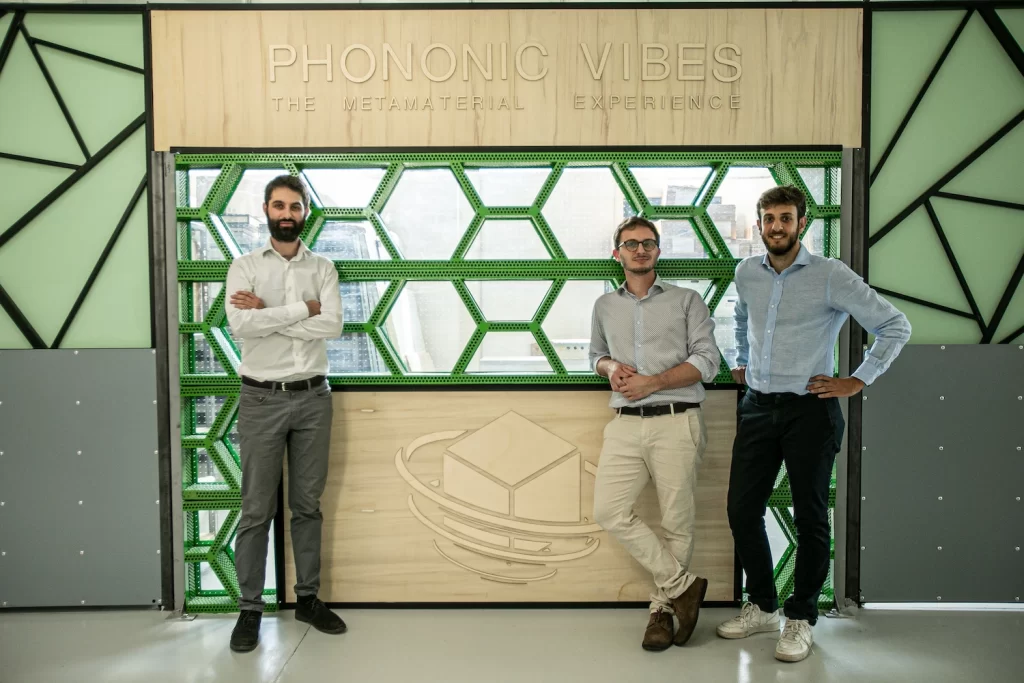Forbes has dubbed them "the engineers of silence": Luca D’Alessandro, Giovanni Capellariand Stefano Caverniare three Politecnico's Alumni, researchers and founders of the start-up Phononic Vibes, born in 2018 as a Politecnico di Milano's spin-off which has recently won a 6 million euro funding round.

Underpinning this rapid rise is an invention (and 12 patents): a modular device for the isolation of low-frequency and broad-spectrum vibrations, in other words noise and vibration absorbing panels made of "labyrinth metamaterials" capable of absorbing both sound and mechanical waves. These metamaterials are artificially created with specific electromagnetic properties that distinguish them from other materials; their macroscopic characteristics depend not only on their molecular structure but also on their structural geometry.
They have a unique "labyrinth-like" designthat allows the wave to be reflected several times within the structure, thus progressively reducing until it disappears. Its periodic structures are made from materials commonly used in civil and mechanical engineering, such as steel and concrete, or even 3D-printed recycled plastics. Several of the devices can be assembled side by side to create a true soundproof barrier. The device is therefore able to limit the propagation of vibrations, both elastic and acoustic, generated by traffic, machinery and equipment, with the aim of mitigating against both structural damage to buildings and noise associated with an urban environment. Fonte: Polilink
Phononic Vibes' special feature is its panels, which are 3D-printed from waste plastic and enable a vibration reduction several orders of magnitude higher than that achieved by currently available technologies on the market, all at a significantly lower cost. It can eliminate many types of noise - from medium-frequency sounds, characteristic of speech and some musical instruments, to low-frequency sounds, caused by engines. It also has a wide range of applications, from construction to automotive to domestic uses.

Forbes has reported that the technology has passed the scrutinyof what has become known as the "Harvard of transport", i.e., Deutsche Bahn, the German railway company. "We developed a transparent, highly absorbent panel to be used around stations or railway tracks, as an alternative to the steel walls currently used to reduce noise pollution," says D'Alessandro. "A glass window has a completely different effect in an urban area, as glass usually reflects sound, instead of absorbing it.” Unlike the one produced by Phononic Vibes.
Phononic Vibes’ journey is one of many examples of how the technology transfer of the Politecnico di Milano has a concrete impact on the high-tech industry, bringing the results of research activities out of the laboratories and into the corporate world.
Giovanni Capellariobtained his PhD degree from the Politecnico di Milano in 2018 with a thesis in Machine Learning, in addition to working and spending several months at the ETH University in Zurich.Stefano Cavernigraduated in Civil Engineering in 2017 with a thesis in the field of metamaterials, having specialised in Structures.
Luca D’Alessandroreceived his PhD from the Politecnico di Milano, after having also spent a period of time abroad at MIT in Boston, specialising in the field of metamaterials and the optimisation of periodic structures for acoustic and vibration isolation. It was actually Luca's PhD thesis that was the starting point for the start-up. After participating in Switch2Product, the Politecnico di Milano's Innovation Challenge, Luca decided to embark on this entrepreneurial path by partnering with the two other founders Giovanni, a PhD colleague, and Stefano, a colleague and thesis student at the Politecnico di Milano. The business has experienced rapid growth, with its operational team now consisting of 10 people. Fonte: Fondazione Politecnico di Milano, “Il coraggio di innovare”